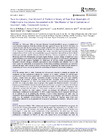Two Sculptures, One Master? A Technical Study of Two Rare Examples of Polychrome Sculptures Associated with "the Master of Saint Catherine of Gualino", Italy, Fourteenth Century
Abstract
Between the 1960s and 1990s art historian Giovanni Previtali identified a group of polychrome wood trecento sculptures from the Umbrian-Abruzzo region of Italy as the work of one hand. He named his artist the Maestro della Santa Caterina Gualino after one of the pieces considered to epitomize the style he had identified. Previtali's attribution has since been universally accepted in art historical publications and catalogs. This study tests this assertion through scientific analysis of two of the sculptures named in the group. A team from National Museums Scotland, Edinburgh and the Isabella Stewart Gardner Museum, Boston compared a statue of the Madonna and Child (Edinburgh) and Saint Agnes (Boston) using a variety of analytical tools. Cross-references were made to three other sculptures in the group to which access was gained. The results of this analysis highlight the challenges of testing stylistic associations in the laboratory. Despite taking a scientific approach to data collection and collation there is still much scope for subjectivity in interpretation. Rather than providing a conclusion, our work has opened the door wider still for multiple interpretations, illustrating the limitations of analysis in supporting definitive statements about the authorship of Medieval polychrome sculpture. Show more
Permanent link
https://doi.org/10.3929/ethz-b-000642071Publication status
publishedExternal links
Journal / series
Journal of the American Institute for ConservationVolume
Pages / Article No.
Publisher
RoutledgeSubject
Master of Saint Catherine of Gualino; Umbria; fourteenth century; polychrome sculpture; paint analysis; Radiocarbon dating; under-drawing; connoisseurshipOrganisational unit
03868 - Eglinton, Timothy I. / Eglinton, Timothy I.
More
Show all metadata
ETH Bibliography
yes
Altmetrics





